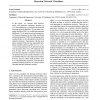Free Online Productivity Tools
i2Speak
i2Symbol
i2OCR
iTex2Img
iWeb2Print
iWeb2Shot
i2Type
iPdf2Split
iPdf2Merge
i2Bopomofo
i2Arabic
i2Style
i2Image
i2PDF
iLatex2Rtf
Sci2ools
ICML
2005
IEEE
2005
IEEE
Discriminative versus generative parameter and structure learning of Bayesian network classifiers
In this paper, we compare both discriminative and generative parameter learning on both discriminatively and generatively structured Bayesian network classifiers. We use either maximum likelihood (ML) or conditional maximum likelihood (CL) to optimize network parameters. For structure learning, we use either conditional mutual information (CMI), the explaining away residual (EAR), or the classification rate (CR) as objective functions. Experiments with the naive Bayes classifier (NB), the tree augmented naive Bayes classifier (TAN), and the Bayesian multinet have been performed on 25 data sets from the UCI repository (Merz et al., 1997) and from (Kohavi & John, 1997). Our empirical study suggests that discriminative structures learnt using CR produces the most accurate classifiers on almost half the data sets. This approach is feasible, however, only for rather small problems since it is computationally expensive. Discriminative parameter learning produces on average a better clas...
Bayesian Network Classifiers | Conditional Maximum Likelihood | Discriminative Parameter | ICML 2005 | Machine Learning |
Related Content
| Added | 17 Nov 2009 |
| Updated | 17 Nov 2009 |
| Type | Conference |
| Year | 2005 |
| Where | ICML |
| Authors | Franz Pernkopf, Jeff A. Bilmes |
Comments (0)

